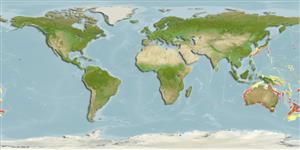Klassifizierung / Names
Namen | Synonyme | Catalog of Fishes(Gattung, Arten) | ITIS | CoL | WoRMS | Cloffa
Elasmobranchii (Haie und Rochen) (sharks and rays) >
Torpediniformes (Electric rays) >
Torpedinidae (Electric rays)
Eponymy: Francis Alexander ‘Frank’ McNeill (1896–1969) was an Australian ichthyologist and carcinologist at the Australian Museum in Sydney. [...] (Ref. 128868), visit book page.
More on author: Whitley.
Environment: milieu / climate zone / Tiefenbereich / distribution range
Ökologie
seewasser bathydemersal; tiefenbereich 90 - 750 m (Ref. 9917). Deep-water
Eastern Indian Ocean: southern Australia, from Port Headland to Tasmania and off the Swain Reefs in Queensland. Torpedo macneilli is similar and probably synonymous with Torpedo fairchildi from New Zealand (Ref. 12951).
Length at first maturity / Size / Gewicht / Alter
Geschlechtsreife: Lm ?, range 60 - ? cm
Max length : 107 cm TL Männchen/unbestimmt; (Ref. 9917)
An offshore species found on continental shelves and slopes (Ref. 9917, 75154). Found near rocky reefs, over sand and mud bottoms (Ref. 12951). Feeds on fishes and crustaceans (Ref. 12951). Ovoviviparous (Ref. 50449). Capable of severely shocking people if handled (Ref. 9917).
Life cycle and mating behavior
Geschlechtsreife | Fortpflanzung | Ablaichen | Eier | Fecundity | Larven
Exhibit ovoviparity (aplacental viviparity), with embryos feeding initially on yolk, then receiving additional nourishment from the mother by indirect absorption of uterine fluid enriched with mucus, fat or protein through specialised structures (Ref. 50449).
Compagno, L.J.V. and P.R. Last, 1999. Torpedinidae. Torpedos. p. 1449-1451. In K.E. Carpenter and V.H. Niem (eds.) FAO identification guide for fishery purposes. The living marine resources of the Western Central Pacific. FAO, Rome. (Ref. 9917)
IUCN Rote Liste Status (Ref. 130435: Version 2025-1)
Nutzung durch Menschen
Fischereien: nicht kommerziell
Tools
Zusatzinformationen
Download XML
Internet Quellen
Estimates based on models
Preferred temperature (Ref.
123201): 10.4 - 20.6, mean 14.1 °C (based on 128 cells).
Phylogenetic diversity index (Ref.
82804): PD
50 = 0.5001 [Uniqueness, from 0.5 = low to 2.0 = high].
Bayesian length-weight: a=0.01479 (0.00665 - 0.03288), b=2.96 (2.77 - 3.15), in cm total length, based on LWR estimates for this (Sub)family-body shape (Ref.
93245).
Trophic level (Ref.
69278): 4.0 ±0.65 se; based on food items.
Widerstandsfähigkeit (Ref.
120179): sehr niedrig, Verdopplung der Population dauert mehr als 14 Jahre. (Preliminary K or Fecundity.).
Fishing Vulnerability (Ref.
59153): High vulnerability (64 of 100).
🛈
